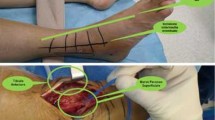Abstract
The term pilon fracture was introduced to describe these complex injuries by Destot in 1911. Their frequency is relatively low, about 1% of all lower limb fractures, with higher incidence in the 3rd and 5th decade. These fractures may be caused by falls, road accidents or sport injuries. Tibial plafond fractures may be produced by two different dynamics: shear-stress injuries, which separate bone fragments, and compression injuries, which compress and impact bony matter. Muller’s AO classification is the more complete and universally accepted system: it characterizes Type A (not articular), type B (partially articular) and type C (completely articular) fractures.
Accident dynamics, preexisting conditions of the involved part and general health status of the patient are the three anamnestic hot points. A correct sequence of evaluation, taking account of presentation, classification and soft tissue examination, turns out to be crucial in directing the surgical timing, the access and the technique adopted.
An incorrect diagnostic-therapeutic timing could produce unsatisfactory results, with variable degrees of posttraumatic arthritis and patient disability.
Similar content being viewed by others
Bibliografia
Destot E (1911) Traumatismes du pied et rayons X: malleoles, astragale, calcaneum, avantpied. Masson, Paris pp. 1–10
Teeny SM, Wiss DA (1993) Open reduction and internal fixation of tibial plafond fractures. Variables contributing to poor results and complications. Clin Orthop 292:108–117
Muller ME, Allgöwer M, Schneider R et al (1991) Manual of internal fixation, 3rd ed. Springer, Berlin Heidelberg New York
Bacon S, Smith WR, Morgan SJ et al (2008) A retrospective analysis of comminuted intra-articular fractures of the tibial plafond: Open reduction and internal fixation versus external Ilizarov fixation. Injury 39:196–202
Lauge-Hansen N (1953) Fractures of the ankle. V. Pronation-dorsiflexion fracture. AMA Arch Surg 67:813–820
Barei DP, Nork SE (2008) Fractures of the tibial plafond. Foot Ankle Clin 13:571–591
Rüedi TP, Allgöwer M (1979) The operative treatment of intra-articular fractures of the lower end of the tibia. Clin Orthop 138:105–110
Kellam JF, Waddell JP (1979) Fractures of the distal tibial metaphysis with intra-articular extension — the distal tibial explosion fracture. J Trauma 19:593–601
Anderson JT, Gustilo RB (1980) Immediate internal fixation in open fractures. Orthop Clin North Am 11:569–578
Tscherne H, Oestern HJ (1982) A new classification of soft-tissue damage in open and closed fractures. Unfallheilkunde 85:111–115
Author information
Authors and Affiliations
Rights and permissions
About this article
Cite this article
Torasso, G., Cuocolo, C., Sabatini, L. et al. Le fratture del pilone tibiale: inquadramento e classificazione. LO SCAL 24, 85–88 (2010). https://doi.org/10.1007/s11639-010-0066-2
Published:
Issue Date:
DOI: https://doi.org/10.1007/s11639-010-0066-2




